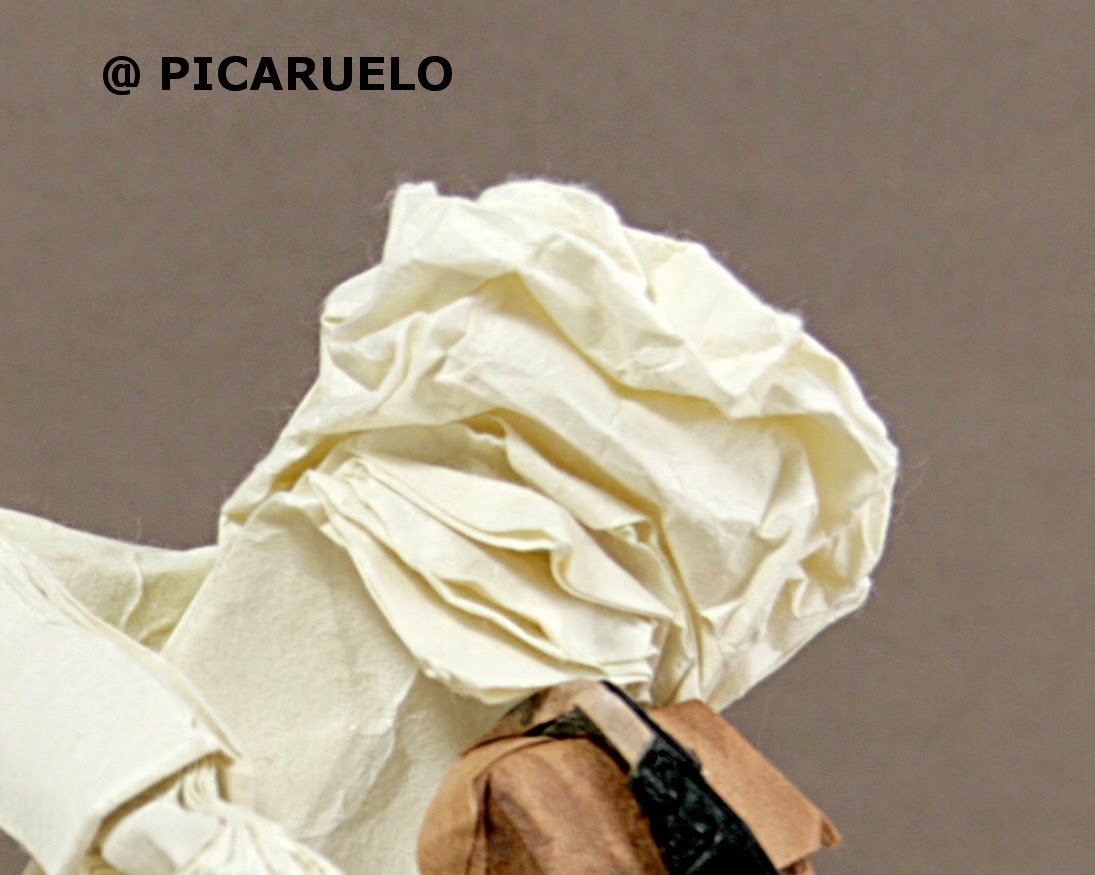Today, I am very happy to present my new model a TROMBONIST, a FEMALE TROMBONIST:
The long hair would be a mix between the crumpled violinist hair and the long hair of the drummer:
The face would be the violinist face trying to make it as smooth as possible:
The big breast and thin waist would follow the stile of my Spanish Dancer:
Once I knew what I wanted to create I began with the technical part of the design. The first thing was to draw the tree diagram:
I soon realised the tree was very similar to the drummer's tree. In the drummer the breast flap is longer and folds flat on top of the body. I began to work with my drummer's CP and after some adjustments to lengthen the hair flap and shorten the breast flap I came out with my trombonist CP:
It is important to notice the bottom of the CP. The lines running down slowly fade away before the paper ends. They are the skirt. If we wanted to collapse the base and make it lie flat on a table we would need to fold them fully down. It isn't our case. We want to make a 3D skirt with as few creases on the paper as possible.
We can compare both CPs, trombonist and drummer, painting similar areas in the model with the same colours. Both of them are 32x32 grids:
We can compare both CPs, trombonist and drummer, painting similar areas in the model with the same colours. Both of them are 32x32 grids:
The hair is pink. It measures three units in both models but in the trombonist there is a 'green' river that adds two additional units. So we have five units for the trombonist vs three for the drummer. In yellow we have the face. Four flaps the trombonist vs three for the drummer. The fourth extra flap let me fold the mouth. With the drummer I didn't fold the mouth because I could add a moustache. The neck is blue. It's longer in the drummer (3 units vs 1). The breast is red. In the drummer it is 3 units, the same length as the body so that is can fold on top of it. The arms are grey. They are 10 units long in both models. The fingers are similar.
For the final model I have used kozo paper, a 45x45 cm square. The final height of the model is 20,5 cm. Let us see the folding process:
 |
| Back view |
 |
| Front view |
 |
| Collapsed model |
The skirt bottom can be folded inward to adjust the model height. At the same time this fold helps to close the model:
And finally, we reach the detailed modelling. It is surprisingly easy compared to other dwarves. It also closes on itself very nicely without need of much wet folding with methyl cellulose. It is probably the music that has taken me less time to model.
This model, once folded, is like a noble woman in court, a MILADY, and so that is how I have named her before adding any music instrument so than she becomes the ninth member of my music band:
This model, once folded, is like a noble woman in court, a MILADY, and so that is how I have named her before adding any music instrument so than she becomes the ninth member of my music band:
The woman took me long working hours but folding the instrument was very straightforward. The trombone CP was deduced and released in his flickr by Ricardo Montecinos:

The collapsing process is very simple. Here you have a photo of a preliminary model just after completing the collapse:
And here is the final model, I used a rectangular kozo paper, 36x6 cm. The final length of the model is 9 cm. I painted it with deep gold acrylic:
And as an ending of this post here you have the model from different perspectives:

The collapsing process is very simple. Here you have a photo of a preliminary model just after completing the collapse:
And here is the final model, I used a rectangular kozo paper, 36x6 cm. The final length of the model is 9 cm. I painted it with deep gold acrylic:
And as an ending of this post here you have the model from different perspectives:





















